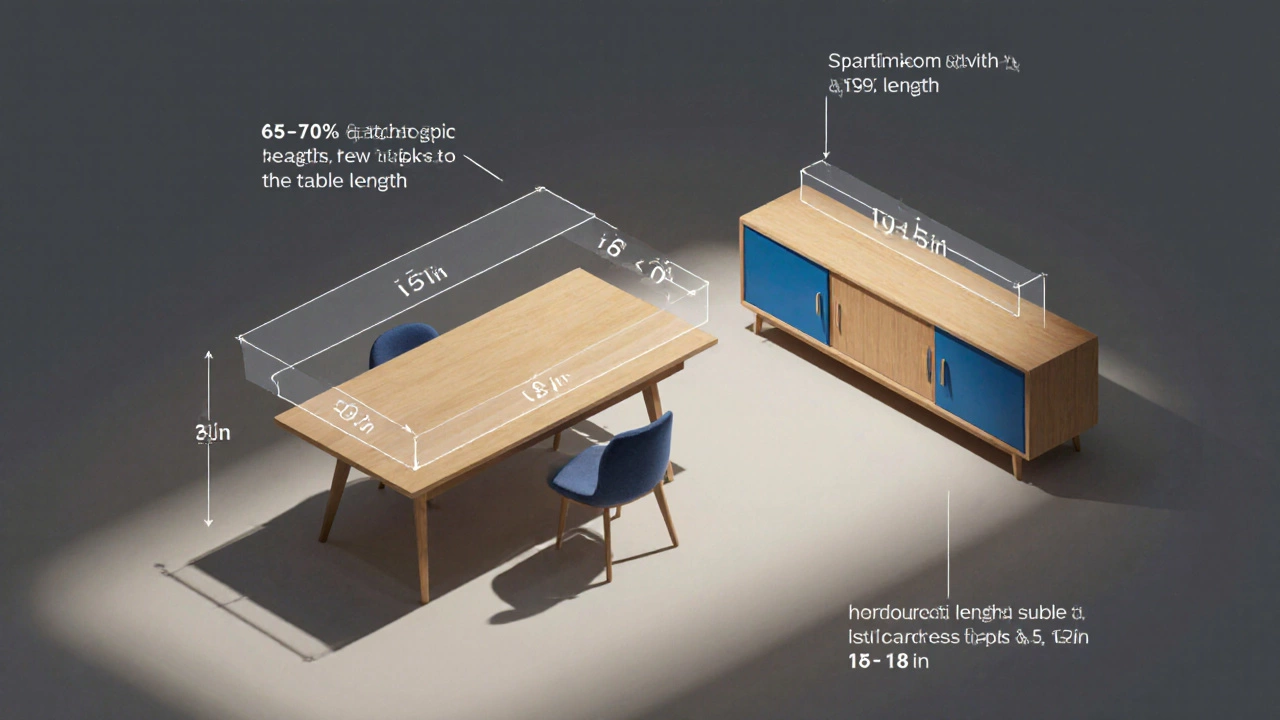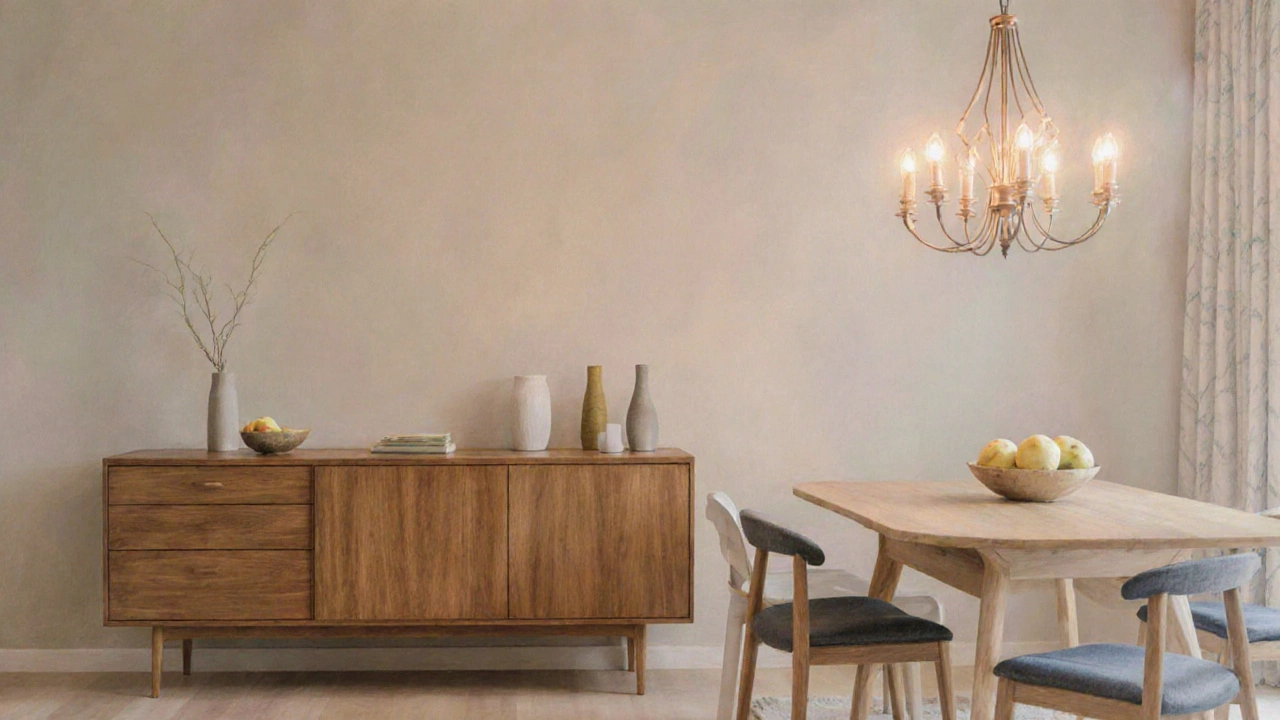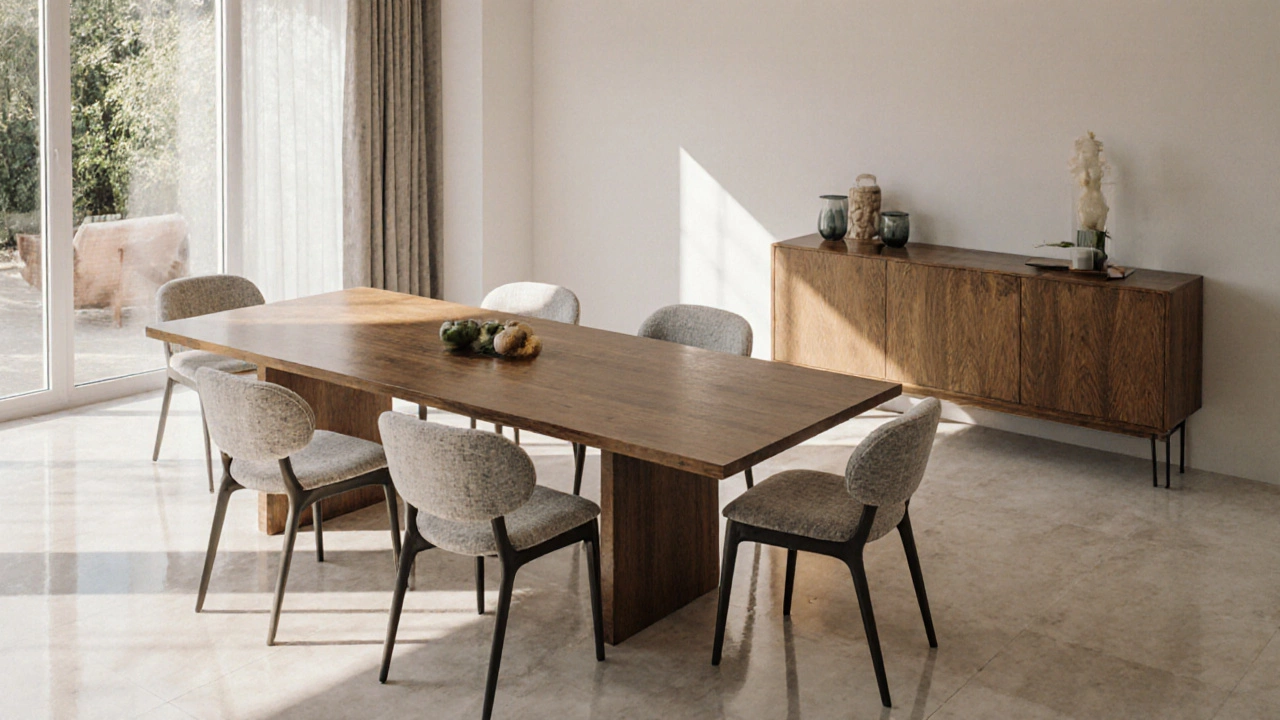Sideboard Size Calculator
Input Your Table Dimensions
Key Sizing Rules
Sideboard should be 65-75% of table length
Sideboard top should be 12-15 inches below table height
Sideboard depth should be 15-18 inches
Ideal Sideboard Dimensions
Recommended: 65-75% of table length for balanced proportions
Choosing the right sideboard for your dining area often feels like guessing. Too big and it overwhelms the room; too small and it looks out of place. This guide breaks down exactly how to match a sideboard’s dimensions to any dining table, so you can avoid costly mistakes and create a balanced space.
Understanding Furniture Proportions
In interior design, proportion is the relationship between the size of one piece and the space it occupies. For dining rooms, the most critical ratio is between the sideboard and the table. A well‑proportioned sideboard enhances flow, supports traffic, and adds visual harmony.
Design experts use three simple rules of thumb:
- Length rule: the sideboard should be roughly 65‑75% of the table’s length.
- Height rule: keep the top surface within 12‑15 inches of the table height.
- Depth rule: a depth of 15‑18 inches works for most standard tables.
These numbers aren’t arbitrary; they stem from decades of residential design research and real‑world testing.
Standard Dimensions for Dining Tables
Dining Table is a central piece of furniture used for meals, typically ranging from 30‑40 inches in height and varying widely in length. The most common shapes and their standard lengths are:
| Shape | Seating Capacity | Length (inches) |
|---|---|---|
| Rectangular (4‑person) | 4 | 48‑60 |
| Rectangular (6‑person) | 6 | 72‑84 |
| Rectangular (8‑person) | 8 | 96‑108 |
| Round | 4‑6 | 36‑48 (diameter) |
| Oval | 6‑8 | 72‑96 (length) |
Knowing the exact length of your table is the first step to picking a sideboard that feels right.
Typical Sideboard Sizes
A sideboard, also known as a buffet, is a low, long storage piece placed against a wall. Its chief purpose is to hold serving dishes, linens, and sometimes a wine cabinet.
Standard dimensions (in inches) look like this:
- Length: 48‑84
- Depth: 15‑18
- Height: 30‑36 (top surface around 12‑15 inches below table height)
Smaller sideboards (under 48 inches) are often called credenzas and are better suited for kitchens or hallways rather than a dining room.

How to Match Sideboard to Your Table
Now that you have the numbers, let’s turn them into a simple calculation. Suppose your dining table is 78 inches long. Apply the length rule:
- 78 inches × 0.65 = 50.7 inches (minimum sideboard length)
- 78 inches × 0.75 = 58.5 inches (maximum sideboard length)
So a sideboard between 51 and 58 inches works best. If you prefer a more subtle look, aim for the lower end; for a bolder statement, choose the higher end.
Next, check the height rule. Most dining tables are 30 inches high. Subtract 12‑15 inches, and you get a sideboard top height of 15‑18 inches - that matches the common 12‑15 inch clearance most designers recommend.
Depth is straightforward: keep it under 18 inches to avoid crowding chairs. If your room is narrow (under 12 feet wide), stay closer to 15 inches.
Practical Tips for Different Room Layouts
When it comes to choosing the right sideboard size, consider these real‑world scenarios:
- Small dining room (under 10×10 ft): Opt for a sideboard on the 65% length side. A 48‑inch sideboard pairs nicely with a 72‑inch table, leaving ample walking space.
- Open‑plan space: You can stretch to the 75% rule, or even go a bit larger if you want the sideboard to act as a visual divider.
- Round tables: Because round tables lack a clear length, measure the diameter and apply the same 65‑75% rule. A 42‑inch round table (typical 4‑person) works well with a 30‑35 inch sideboard.
- Low ceiling rooms: Keep the sideboard height modest (under 34 inches) to maintain proportion with the vertical space.
- High‑traffic zones: Ensure a minimum of 36 inches clearance between the sideboard and the nearest chair to allow smooth movement.

Common Mistakes to Avoid
Even seasoned homeowners slip up. Here are the top pitfalls and how to fix them:
- Oversized sideboard: If the sideboard eclipses the table, the room feels cramped. Trim the length or choose a slimmer profile.
- Too shallow: A 12‑inch depth can look like a decorative shelf rather than functional storage. Aim for at least 15 inches.
- Mismatched height: If the sideboard top is too close to the table, diners can’t see each other. Keep a 12‑15 inch gap.
- Ignoring traffic flow: Place the sideboard where it blocks the path from kitchen to table. Ideally, it should sit along a wall that doesn’t interrupt the main aisle.
- Choosing the wrong material: Heavy wood can dominate a light‑filled room; glass or metal accents work better in minimalist settings.
Quick Reference Guide (Checklist)
- Measure your dining table’s length, width, and height.
- Calculate sideboard length: table length × 0.65‑0.75.
- Confirm sideboard depth ≤ 18 inches (prefer 15 inches for narrow rooms).
- Check height clearance: table height - 12‑15 inches.
- Allow at least 36 inches of walking space around the sideboard.
- Match material and style to the rest of the room.
Frequently Asked Questions
What is the ideal length ratio between a sideboard and a dining table?
The sideboard should be about 65‑75% of the table’s length. This range keeps the pieces visually balanced while preserving space for movement.
Can I use a credenza instead of a sideboard?
Yes, but credenzas are usually under 48 inches long and lower in height. They work best in smaller rooms or as secondary storage, not as a primary dining sideboard.
How much clearance should I leave between chairs and the sideboard?
Leave at least 36 inches from the edge of the sideboard to the nearest chair back. This ensures diners can pull out and sit comfortably.
Does the sideboard’s style affect the sizing rules?
Style matters for visual weight. A sleek, low‑profile sideboard can appear smaller than its actual dimensions, giving a bit of flexibility around the 65‑75% rule.
What if my dining table is irregular, like an oval?
Measure the longest point of the oval (its length) and apply the same percentage range. For a 90‑inch oval, aim for a sideboard between 58 and 68 inches.

